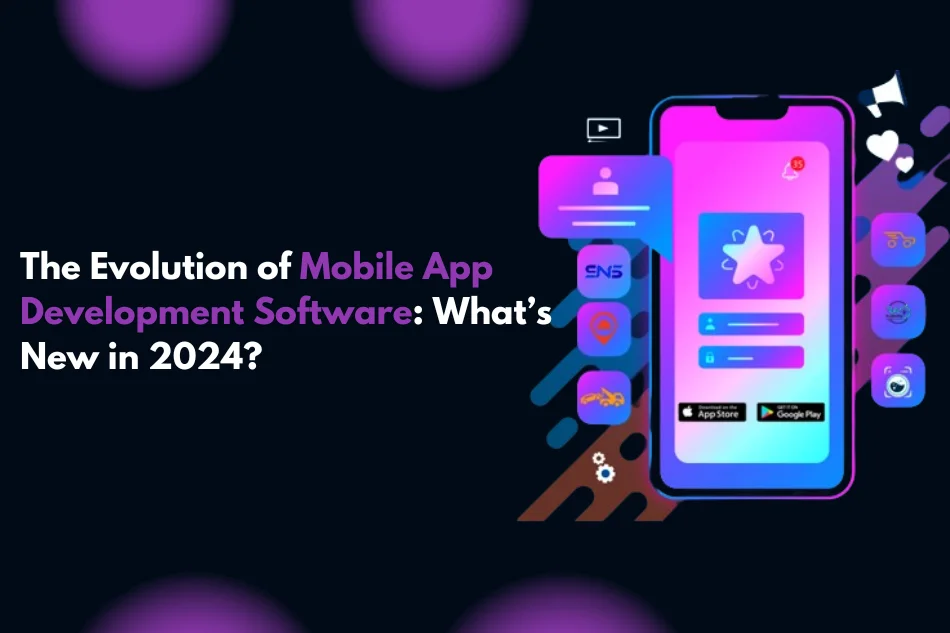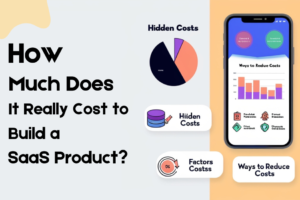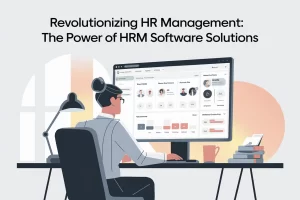The Evolution of Mobile App Development Software: What’s New in 2024?

Table of ContentsToggle Table of ContentToggle
In the fast-moving world of technology, mobile app development software is always on the move and in enhancement. Entering 2024, gigantic strides will be made as to how apps are created and utilized on phones and tablets. New-age tools and frameworks make it much easier to create really working apps that can do much more cool stuff.
These are the software tools; imagine a box of tools for developers. These have everything in them, from programs meant for special devices to smart tools that help in coding. The focus in 2024 is going to be all about making apps faster and better. With its new technologies like AI and machine learning that make them smarter.Think of these tools as the keys that will unlock some incredible possibilities for developing even more powerful, easy-to-use apps than ever before.
The Main Motive of the Blog
Our Mobile App Development Software blog series ushers you into an exciting world in 2024 on the discovery of new, exciting trends and innovation shifts in how apps would be created, used on your smartphones, and tablets.
From ground-breaking low-code platforms that make a lightning-fast process in the development of apps to the new AI tools that enhance the performance of apps in ways previously unimagined, 2022 is all about pushing boundaries.
Whether you are a seasoned developer of mobile applications or just entering this area of activity, all the trends are worth getting familiar with. These trends are not bringing changes to the way apps are built but also define the future of software development in large. Join us in our run-through of these advancements. Find out how they’re transforming the mobile applications landscape.
Importance of Keeping Updated About the Trends in Mobile App Development

The knowledge of trends in mobile app development is not only useful but also critical in making awesome apps, staying competitive, and growing your career in the exciting world of mobile technology!
Stay Updated with New Tech: Keep learning about new tools, including React Native and Flutter, to quickly develop applications that run on all devices.
Make Users Happy: Know what the user wants by following the latest trends in the development of mobile apps. Build the new-age apps that are loved by people and are easy to use.
Manage Big Challenges: Learn about cyber security and privacy to keep information from users safe and sound. Also, manage complex tasks like AI smoothly in your apps.
Grow Your Career: Learning new things helps you to grow in your job. Being updated shows that you are ready for what’s next in mobile application development.
One step ahead of others: Know the new trends and thus develop better apps than most of your competitors. Boosting of ranking within stores.
Connect and Learn: Meet fellow developers, exchange ideas, and learn desde skills. At the forefront of what goes on around; improve your app-making skills.
Work faster and better: Know the top tools to develop apps fast and smarter. Get more done in less time.
Plan for Tomorrow: Squint forward in one’s mind’s eye and remember the view of that path mobile apps crawl for where it will take them next. Be ready for things to come about to keep the apps relevant, accepted, and popular.
What is Mobile App Development Software?
It is the power of dynamic toolsets that is able to help mobile app development software turn concepts into real-life applications that run on both smartphones and tablets. These systems smoothen out the cycle of an app—from concept to deployment and maintenance. These satisfy varied criteria, which include high-end user interfaces to strong backend communication. High-performance optimization for iOS and Android systems will go in line with a dependable testing framework and highly effective deployment tools. It ensures that every app can satisfy all the requirements put forth, both for functionality and user experience. No matter how experienced a developer or how young an app business is, these very software solutions. It will unleash your creativity in the ever-changing world of mobile technology and can thus be used for both.
Brief history of mobile app development tools
With the introduction of mobile app creation tools, it really has made a big difference in how we use our smartphones today. In the early part of the millennium, much of developers’ attention was focused on writing native applications for both iOS and Android. This basically made development easier because it became possible to attain cross-platform execution with code once written. With frameworks like Ionic, React Native, and Flutter at its disposal, hybrid and web-based application development was achieved with the use of web technologies like HTML5, CSS, and JavaScript. IDEs, such as Android Studio and Xcode, have long provided the means to develop, test, and deploy mobile apps. Scalable backend capabilities through cloud computing platforms like Firebase and AWS Mobile meant that developers were free to focus on the logic and experience of the apps. It was developed under user-friendly design and testing of the user experience with the help of Adobe XD, Sketch, and Figma. Machine learning and AI capabilities have been added to mobile app development recently. This has enhanced the level of user engagement and customization. CI/CD practices: Systems such as Jenkins, GitLab CI, have maintained the quality and stability of the apps while quickly delivering updates.
Why is Understanding the Evolution Important?
It extends from keeping pace with the evolution of technology down to understanding precisely how Mobile App Development has changed—from platforms to software for generating apps. But these developments come to mean one thing: using them at best-in-class creativity, productivity, and user-friendliness towards success. If in this cutthroat world of mobile applications. Knowing how to keep up with all these developments allows one to develop very special applications in such an exciting area as mobile application development, and setting. The standard as a developer and company, at the same time provides an opportunity to thrill consumers.
Impact on App Developers and Businesses:
Stay Competitive: Knowing the very latest in mobile apps, and being comfortable with the best tools at the developer and businesses disposal. This can at best give them that slim chance of outranking the competition or developing more useful programs to cater to the needs of this newest base of users.
Adaptability: Keeping up with the evolution of mobile application development. Therefore important to ensure that developers are able to change their approach and strategies to adapt to evolving trends. It means innovativeness helps to be competitive and up-to-date in this fast-paced arena of the app industry.
Customer Satisfaction: The trends that change around mobile app technologies and selections of a platform are what mostly influence user experience. By keeping themselves updated, developers can come up with user-friendly apps matching modern standards. thus users find them more engaging and rewarding to retain.
Key Elements of Mobile App Development Software:
Mobile app development software is basically a very powerful, dynamic toolkit allowing developers to come up with outstanding, safe, and intuitive mobile apps. It eases not only the coding phase but also the design, testing, and deployment. With these features, basically, this software will not only meet the expectations of consumers but also will be an excellent medium by which developers can express themselves to the fullest. Quickly succeed in this hectic field of developing mobile applications. All this points to making the most of them to innovate, create outstanding user experiences, and differentiate in an overcrowded industry.
Overview of Essential Features and Capabilities as Mobile App Development

One may say that mobile application development tools are a powerhouse of tools that make it possible for the developer to build scam-free, user-friendly, and secure world-class applications. It is then that potentiality will be unfolded. Ability to optimize processes develops with them in a way that effortlessly improves a lot of performances within the app. With that comes guaranteeing meets the ever-evolving needs of both businesses and consumers in the mobile app industry. It helps in inefficient coding and testing, making strong and intuitive applications that would strike a chord among their users. It means bringing ideas to life and designing high-end user experiences that involve users. It creates an edge over others in the competitive app ecosystem.
All-round development tools: Development software for mobile applications provides all sets of tools for design, coding, testing, and deployment. This spans from IDEs, code editors, and debuggers targeting mobile-specific platforms such as iOS and Android.
Cross-Platform Compatibility: Perhaps one of the best characteristics of the majority of mobile app development tools is their cross-platform development support. For example, Xamarin, React Native, and Flutter offer a facility for developers to write once and deploy all at a time on a number of different platforms. That definitely bodes well with developmental time and cost by bringing consistency to the user experience across devices.
Scalability is critical because apps may allow various levels of user traffic and data volume. Development software for mobile apps provides scalable solutions that should grow with the user base of an application. It is, therefore, very essential that performance remains optimal under increasing demands.
Integration with Backend Services: Many of the most prominent mobile apps have common backend services like data storage, authentication, and business logic. Mobile application development software integrates well with the cloud platforms of Firebase, AWS Mobile, and Microsoft Azure to use scalable backend services that support both functionality and data management of apps.
User Interface Design Tools: Effective UI design has become essential to hold users’ interest and satisfaction. Therefore, mobile application creation software involves the availability of user interface design tools. the process of making it intuitive and pleasant to the eyes. Features like drag-and-drop editors, re-usable built UI components, prototyping tools, etc. have made developing exciting app designs less painful.
Continuous Integration and Deployment: CI/CD pipelines automate processes for building, testing, and deploying updates to mobile apps quickly and reliably. Mobile application development software is integrated with CI/CD tools like Jenkins and GitLab CI to smooth development workflows while keeping the quality and stability of apps at the forefront.
How Mobile App Development Software Has Evolved
Advancements in the development of tools for mobile apps have enabled developers to express their creativity, come out with effectual, safe, and alluring mobile applications. Cloud computing, optimization of development environments, integration of cutting-edge technology, cross-platform tools, and a high regard for safety allow developers to respond creatively yet confidently to changing requirements within the digital ecosystem.
AI and machine learning integration: Artificial intelligence and machine learning features will be more developed by the developers and then integrated into mobile app development software in 2024. This would also allow for the direct integration of AI models into applications, much like Core ML and TensorFlow Lite, for functions such as natural language processing and image recognition.
More emphasis on AR and VR: Probably the major focus areas with mobile apps these days are AR and VR technologies Development platforms incorporate tools like ARKit for iOS and ARCore for Android to devise applications that are a little more immersive.
Low-Code and No-Code Development: Another significant trend in development is tools offering low-code or no-code development capabilities. The like platforms enable rapid app prototyping and deployment—thus, more attention to app logic and less on traditional coding phases.
Cross-platform development tools: Additional innovations in cross-platform development tools including the likes of Flutter and React Native, demonstrate reasonable performance and near-native experiences across both iOS and Android devices. This greatly reduces development time and costs.
Comparison with previous versions and significant technological changes
Innovation to technology advancement was the evolution of mobile application development. Be it native app development, cross-platform tools, infusion of state-of-the-art technology, refining development environments, moving to a cloud computing environment, or strict measures of safety.Mobile apps have become more powerful, user-friendly, and secure in each version. It now rests in the hands of the developer to harness these advancements to provide a responsive and powerful mobile experience. The dynamic demands of the consumers and the successful domination in the intensely competitive app industry are reaching a crescendo.
Early Days: Native Applications In the early days of mobile app development, most developers used to write native apps for specific platforms like iOS and Android. They would use platform-specific technologies in order to maximize the performance of apps. This includes Java for Android and Objective-C for iOS. It can support all the device-specific features implicitly. The main problem with this approach was that usually having different codebases for a number of platforms increased the time to market and costs.
Shift to Cross-Platform Development: Another very important transformation came with cross-platform development tools like Xamarin, PhoneGap, or Cordova, and then React Native and Flutter. These tools changed the approach toward the development of mobile applications. These enabled development once deployed . This shift reduced development complexities, reduced costs, and increased time-to-market for a mobile app exponentially, improving efficiency and accessibility
It integrated newer technologies, later in the phase of development in mobile app development, like artificial intelligence, machine learning, augmented reality, and virtual reality. Currently, AI and ML models are embedded directly into the app for features such as customized experiences, natural language processing, and predictive analytics. AR and VR technologies further increase the interactivity within the apps and empower experiences. that can be called highly immersive. Something unimaginable a few decades ago, to increase user engagement and satisfaction.
Development Environments : The progress of the IDE for mobile application developers has been huge, such as Android Studio and Xcode. These would be comprehensive tool suites for many different activities concerning the development of mobile applications. such as coding, debugging, testing, and deployment. They would simplify workflows, and enhance collaboration between teams. These support state-of-the-art development processes like modern continuous integration and deployment. Which ensures delivery by faster and more efficient means.
Rise of Cloud Computing and Backend Services
Cloud computing platforms such as Firebase, AWS Mobile, and Azure are changing backend development for mobile apps. Handling data storage, authentication, and push notifications, synchronizing real-time data scalable cloud services. These are now being used by developers. This paradigm shift to cloud-based solutions makes the management of backends easier and increases the reliability and performance features of apps. All these qualities allow more time for developers to innovate and enhance the user experience.
Privacy Features
Privacy has become paramount in the wake of increasing proliferation of mobile apps handling sensitive user data. Current mobile application development packages have protection measures. which include, but are not limited to, strong encryption, safe authentication techniques, and conformance to strict regulations on the protection of personal data. such as GDPR. These measures protect users’ privacy against cyber-attacks. hence, construct trust among the users to ensure a secure environment for app interactions.
Current Trends in Mobile App Development
These trends underline the dynamism of mobile application development in a manner that developers are continuously putting in their efforts toward innovations. Thereby meeting the rapidly changing digital landscape. Adopting these trends unfolds new opportunities for delivering the best user experience across industries.
Overview Defining 2024 Trends
The fast-extending and changing landscape of mobile app development is influenced by new emerging technologies and shifting user expectations. There are a number of trends most likely to take the industry by storm in the year 2024.
AI Integration: Artificial intelligence is relatively new and one of the important components of mobile application development. There are living up to using artificial intelligence by creating more intelligent and customized user experiences that developers can implement. The interactive elements that AI-driven chatbots add to apps are recommendation engines, predictive analytics, and AI itself. Predictive analytics give an interactive dimension to apps.
Sustainability and Green Tech: The development of environmentally friendly mobile applications that reduce energy use, advance digital sustainability, and help with environmental issues is becoming very important.
Cross-Platform Development: With the aid of tools that are becoming increasingly popular, such as React Native, Flutter, and Xamarin, it becomes possible for developers to devise apps with a single codebase. Which run smoothly on iOS and Android. In this way, this provides less design time for a webpage and reduces maintenance costs.
Progressive Web Apps: PWAs occupy the middle ground between web and mobile apps and leverage advantages from both. They preserve the functionality of native apps through a web browser in that they allow offline usage, sending of push notifications, and faster loading times.
Blockchain and Cryptocurrency: Application domains for blockchain technology run much further than the readiness of cryptocurrencies for securing transactions, digital identity verification, and decentralized applications. The inclusion of blockchain in mobile apps will empower safe payments and smart contracts that permit data integrity.
Mobile App Development that Bring Innovations in the 2024:
Case Studies or Examples of Successful Implementations
Successful implementations spell out the practicality of these trends. Artificial Intelligence Integration: AI is used by mobile e-commerce applications for understanding various preferences and behaviours of clients with a view to present them with relevant items, thereby increasing revenue and consumer loyalty while also improving customer satisfaction. This step works for both customer satisfaction and increasing sales and customer loyalty.
Airbnb: With its friendly user interface, Airbnb mobile app development is done with the backing of a powerful backend. They pulled this off by combining React Native, which is a famous framework for building cross-platform apps, with native development. In doing this, they retained consistency in the user experience on several platforms while improving development time and efforts.
Instagram: It was developed as an iOS-only solution, and after that as an Android app, by using Java for the native development of it. They have invested so much in performance and user experience optimization; hence, it grew really fast and became very popular in the social media space.
Pokémon GO: Niantic used Unity 3D game engine with AR and real-world interaction. It gave them a gorgeously visualized, immersive experience that appealed to millions of users worldwide.
WhatsApp: What attracts is that Erlang has built-in concurrent features, and that is why it was chosen to power WhatsApp’s messaging server logic. They can now handle massive data loads, therefore enabling real-time communication between many mobile devices.
Picking the Right Mobile App Tools: What You Need for Success
Perhaps, the choice of mobile app development software tops the list of criteria behind the success of your project. We will consider some of the main factors in regard and look at some popular tools with their unique features.Factors to Consider.
Developer Skill Level:
Match the competence of your development team to any mobile App Development Software. Be it native languages like Java and Swift or cross-platform frameworks. Choose one that goes well with the expertise and experience of years.
Complexity of the Project: Evaluate the complexity of your project
Consider the complexity of your project. For simpler apps, a view into app development software with drag-and-drop interfaces and inbuilt templates for easier design would do. More advanced projects, especially those that need tons of backend integrations or real-time features. It will call for potent frameworks with reliability and customizability at the forefront of their functions.
Platform Compatibility:
Be sure it supports the target platforms for mobile application development. It means either iOS, Android, or both. Cross-platform tools are capable of developing for multiple platforms using a single code base. Examples include Xamarin, React Native, and Flutter.
Development Environment:
Consider the IDE available in the best mobile development tools. Android Studio, Xcode, and Visual Studio offer end-to-end suites for coding, debugging, and testing—customized according to specific platforms.
Community and Support:
Check the community and the available support for your chosen app developers software. The active communities offer resources, tutorials, and forums for solving problems and discussing. The best practices in software development.
The Essential Software for Mobile App Development
Considering the pace at which mobile application development is, out front are advanced software tools such as Android Studio, Xcode, React Native, and Flutter. These are the powerhouse platforms through which innovative solutions help developers create immersive user experiences while harnessing advanced technologies, safely connected to cloud services.
Flutter:
Unique Feature: Flutter: Google’s UI toolkit for building natively compiled applications for mobile, web, and desktop from a single codebase. It is powered by the Dart programming language and provides expressive, fully customizable widgets.
Xamarin:
Unique Feature: One of the notable features of Xamarin is that it uses C# for mobile app development software. This actually means that it will enable programmers to develop platform-specific APIs with performance and fluency like native apps. Since it is a one-time coding technique, the tester deploys, and it will make the mobile application development easy. It is supported by almost all systems, including Windows, iOS, and Android.
React Native:
Unique Feature: React Native is built for developing cross-platform mobile apps by utilizing JavaScript and React. It provides an interface for developing mobile app development software from one codebase itself to be shared across different iOS and Android platforms. This substantially reduces developmental time and effort, due to which it is considered a favourite choice for app development software. It’s aimed at efficiency and consistency in mobile application development.
How to Find and Choose Mobile App Development Software
The correct mobile application development software can be optimal for the success of the project. It’s essential to step through these stages to help navigate you in choosing the correct one.List of important criteria.
Platform compatibility: You must specify the exact platforms for mobile app development that you need to support, either iOS, Android, or both. Choose apps development software with highly developed cross-platform abilities if this is required.
Dev Tools and Frameworks: Assess the impact of Mobile App Development Software tools and frameworks like Xamarin, React Native, or Flutter. These frameworks allow for software development that is effective and scalable.
Set of Skills of a Developer: Consider the expertise of your development team based on the requirements of the app developers’ software). Select the finest mobile development tools supporting their skill set and experiences in various programming languages like Java, Swift, JavaScript, or C#.
Cost and Budget: Observe the pricing style; mobile phone application development is developed through diverse software options. Some would be free, open source, or with a free trial. Others are mechanized as paid subscription plans that have different levels of support and features.
Integration Capabilities: Check how well it integrates with other tools and services. like mobile app development platforms, you use. like cloud services AWS, Firebase, or version control systems like Git.
Support and Community: Look out for a mobile application developer community and support channels for software-associated development. These active communities offer valuable resources, tutorials, and troubleshooting.
Refining Choices Based on Specific Project Needs:

Mobile app development involves strategic decisions that are customized for the needs of every project. Be it starting work on any simple application to making a difficult solution with numerous features, that is where the choice of development software can become very critical. Security and compliance are major issues that need strong features, including data encryption and GDPR compliance. This is as important as the user experience tools to create user-friendly interfaces, and for iterative improvements in accordance with user feedback.
Project Complexity: Based on the project complexity, tailor your choice of Mobile App Development Software. For example, if at all the app is going to be pretty simple, then an intuitive, drag-and-drop interface would work. If complex, then select comprehensive frameworks that come with advanced features.
Security and Compliance: Look for robust security features in the Mobile App Development software. like data encryption, sec ure authentication, and other mechanisms to back up. The best mobile development tools with compliance features to privacy regulations like GDPR.
User Experience: Emphasize the tools used in making easy-to-use, valuable, and eye-pleasing user interfaces in the apps development software. Features that embolden user feedback and iteration in the improvement of user satisfaction software for developing apps should be considered.
Conclusion:-
About Author

Written By Darshan Saroya
Darshan Saroya is the creator and CEO of the content development company. He writes and has over 7+ years of experience as a content marketer, for technoprofiles.com generating on blogging , article's and website technique.





